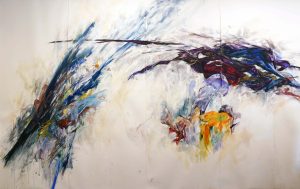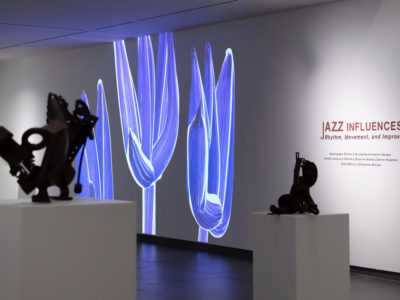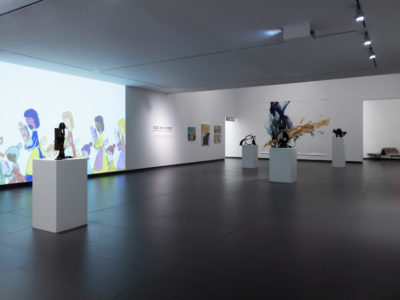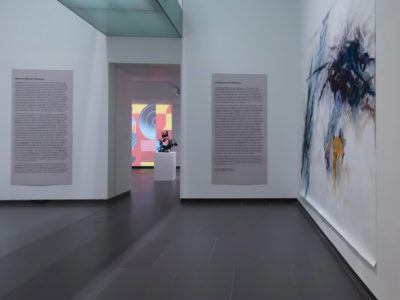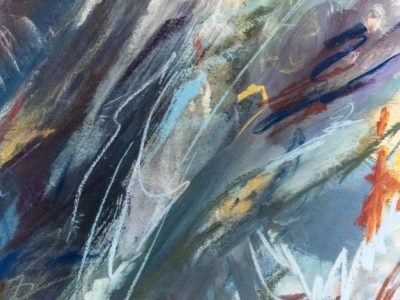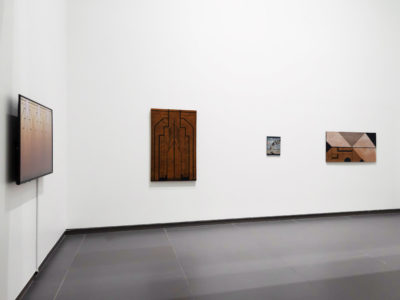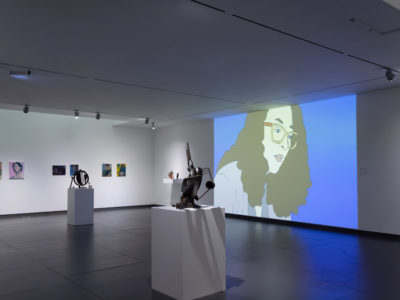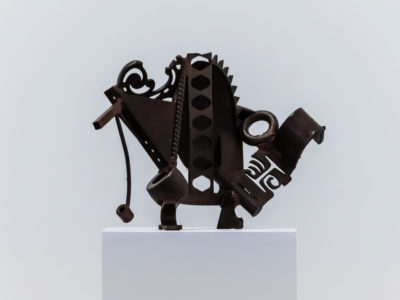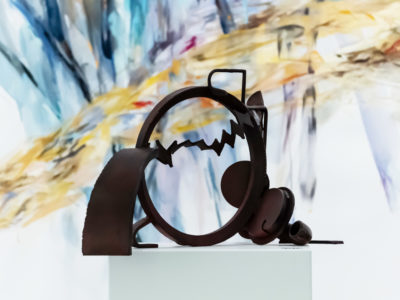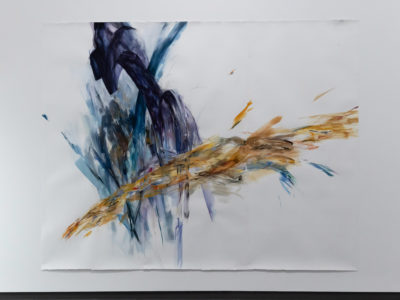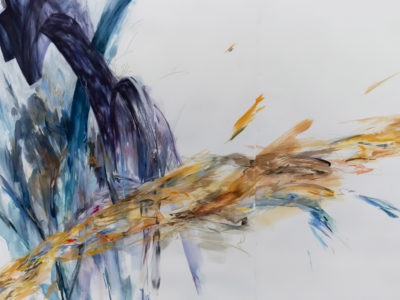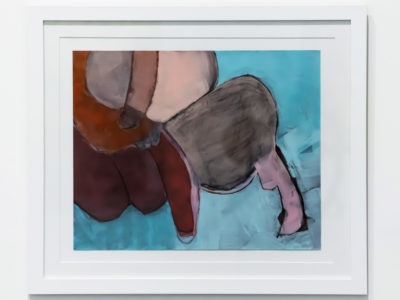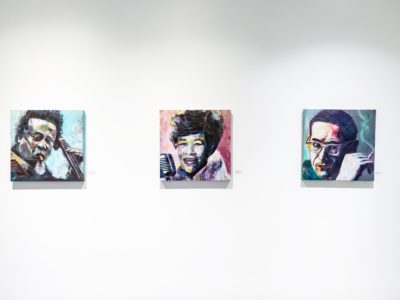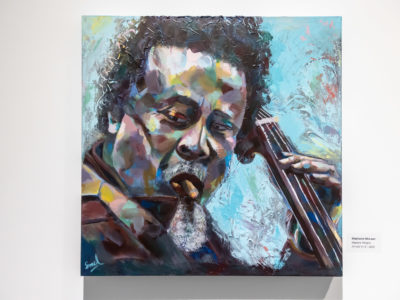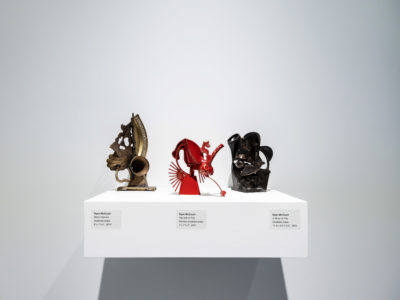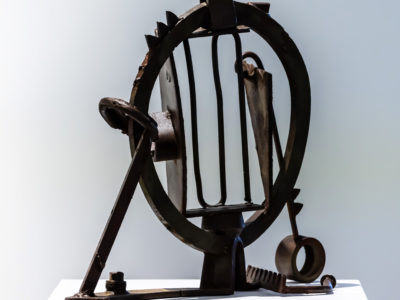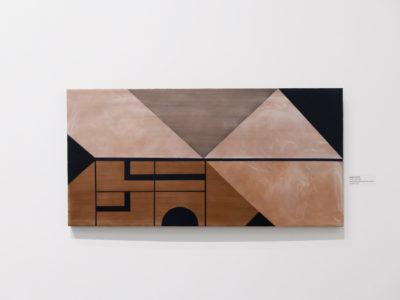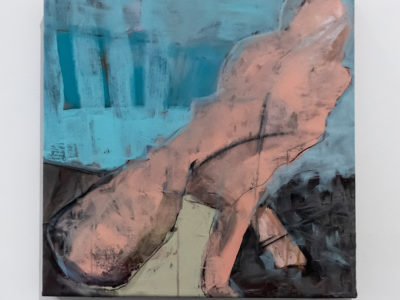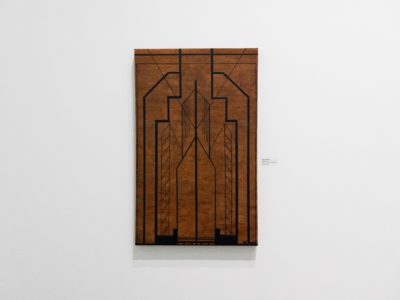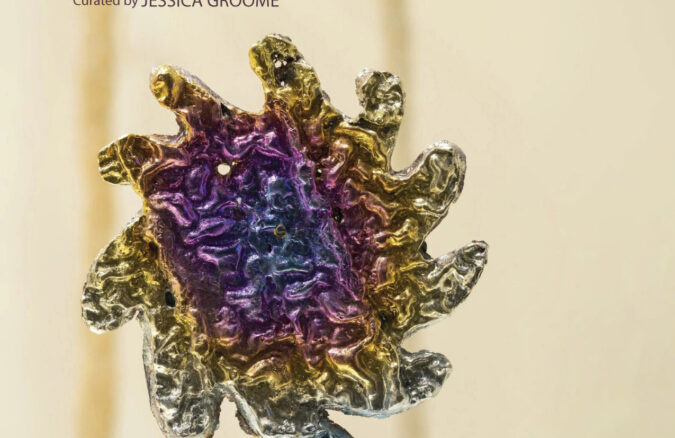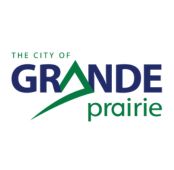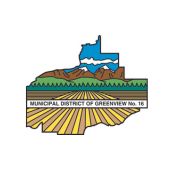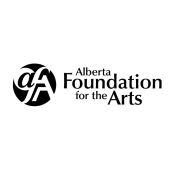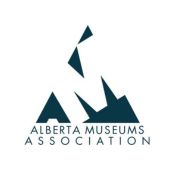Jazz Influences: Rhythm, Movement and Improv!

Jazz Influences: Rhythm, Movement and Improv!
July 21, 2022 - November 6, 2022
Jazz Influences: Rhythm, Movement and Improv! is a multi-disciplinary group exhibition featuring artists from across Canada that explores the history of jazz music and its influences on contemporary art. The artists exemplify ways in which this historical musical genre has inspired various art mediums by emulating abstract and improv elements seen through animation, mixed media, painting, and sculpture.
The exhibition aims to provide space for visitors to learn, engage, and participate in a dialogue about the combination of multiple artistic exchanges and how it can impact the way we experience the arts in our contemporary world.
Curated by Manar Abo Touk, Curator, Exhibitions & Collections
Click to enlarge the exhibition poster
ABOUT THE ARTISTS
BuckingJam Palace & Quickdraw Animation Society
BIO
Nestled in the heart of Calgary’s historic Mount Royal neighbourhood, BuckingJam Palace opens its doors for an intimate listening experience of top-tier jazz. Be one of the sixty guests we welcome into an original 1910 home that was made for music. https://buckingjampalace.com/
Incorporated in 1984, the Quickdraw Animation Society (QAS) is Calgary’s home for independent animation. We promote the art of animation through courses, workshops, screenings, and production resources. https://quickdrawanimation.ca
ARTIST STATEMENT
I found listening to abstract jazz confusing and disorienting until a musician told me to just let the music wash over me. “Think of it like a waterfall,” she said. That image gave me permission to put my critical-thinking brain on hold and just enter into the experience of the music. It made a huge difference. Abstract animation leads us into experience rather than analysis. Colour, movement, shape all flash before our eyes too quickly to parse and without an obviously structured narrative to follow. The visual experiences coaches us on how to experience the music: just let go and let the spectacle unfold. Lisa Buck hopes this film project offers audience: a visual example of a powerful way to listen to jazz.
In a world jammed with distractions, it is vital that we find creative and compelling ways to engage others. If we want to build a community of jazz fans that is diverse in age, gender and culture, we have to present jazz in ways that are approachable, intriguing and accessible to those who have little or no jazz knowledge or experience. For the artists involved, this project presented a unique opportunity to expand their artistic practice. The close working relationships this project provided allowed the artists to explore new ways of integrating the concepts of sound and visuals in their work: musicians are encouraged to “see” their music and animators are encouraged to “hear” their drawings. This isn’t a new idea. The spark for the project goes back to 1949 when Evelyn Lambart— Canada’s first female animator—and Norman McLaren contacted a twenty-four-year-old jazz pianist named Oscar Peterson to compose music for a National Film Board project. It was a true collaboration: Peterson adapted his composition in response to suggestions from the animators (he could play much faster than they could animate) and the animators shaped their creation in response to the pace, dynamics, percussiveness, and melodic lines of the music. The Oscar Peterson trio recorded the music; Lambart and McLaren used ground-breaking techniques of painting directly onto film. The result was Begone Dull Care, a seven-minute tour de force that won six international awards from 1949 to 1954 and is still a delight to watch.
Jazz and animation have stretched and evolved in seventy years. It’s time to revisit a collaboration that will express the creativity of a new generation of artists and expose a new generation of music, film, and animation fans to a powerful example of cross discipline creative synergy.
PROJECT STATEMENT
Toones is a truly collaborative effort, starting with cooperation between Calgary’s BuckingJam Palace and Quickdraw Animation Society. Both organizations were committed to reflecting gender balance and ethnic and gender inclusivity in the artists chosen. We began production in September of 2021 with an initial Zoom meet-up of participants. Animators were introduced to the musicians with whom they would be paired and follow-up meetings were scheduled with each pair to go over the flavour, pace and dynamic range of the piece they would create. Musicians composed and recorded their pieces throughout October and November, with consultation about instrumentation to ensure that each piece had a distinctive character. To keep the sound clean and the budget reasonable, instrumentation was generally kept to a trio and care was taken to represent a spectrum that reflects the wide definition of the genre that is jazz. By disseminating the finished product to a wide audience, we intend to raise the profile of both jazz and animation in Canada, two art forms that Canadians have historically excelled at.
ARTIST COLLABORATORS
Animators:
Noah Spencer is a Calgary-based animator and illustrator with a focus on storytelling and exploring new mediums. They’re a graduate of Vancouver Film School’s Animation and Concept Art program and a current student at the Alberta University of the Arts.
Troy Kokol is an award-winning Canadian singer, producer, animator, video director, and songwriter with over 250 cuts to his name in a variety of music genres, TV, and film. Troy is a recipient of the SOCAN Award for Country Music and a 2-time CCMA Songwriter of the Year nominee. “Like A Record” is the follow-up single to his award-winning album, Lonely Ghost. The multi-talented Indigenous artist wrote, recorded, and engineered the single and later animated the video which was an Official Selection at the GIRAF 2020 international animation festival in Calgary, Alberta, Canada, was nominated for Video of the Year at the Summer Solstice Indigenous Music Awards and received nominations for both Video and Songwriter of the Year at the CMAB Awards and the YYC Music Awards i2021
Sheena Agnew is a 2D freelance animator and illustrator who loves to incorporate elements from their half Japanese background into their work. Sheena graduated from the Alberta University of the Arts in 2019 with a Bachelor of Design and created Quickdraw Animation Society’s 2020 GIRAF Animation Festival’s signal film and poster. They received a QAS Special Jury Award for a Lockdown short film, “Prisma”.
Arielle McCuaig is an artist and musician from Calgary, AB. She is a stalwart of the Calgary arts and music community, having done animation and design for the likes of the GIRAF Festival of Independent Animation and community radio station CJSW 90.9 FM, as well as artwork for bands both locally and internationally. She was the recipient of the Chris J. Melnychuk Scholarship and has produced numerous films through Quickdraw Animation Society. She runs local record label Pee Blood and writes and performs with the bands Hairnet and puppet wipes. The foundation of her practice is based in drawing, heavily influenced by comics, DIY music and outsider art, that works towards a space between loose and laboured, technical and amateur.
Leslie Bell is a visual artist and animator living in Calgary, Alberta. She received her BFA in Painting from the Alberta College of Art (now AUArts) in 2002, and went on to complete her MFA in Studio Arts at Concordia University, Montreal in 2009. Leslie’s animation career began when she received the QAS/NFB first production grant in 2008. Since then she has produced numerous short films, experimental loops and video installations. In 2013, Leslie’s hand-painted animation “Colorado” was included in Pop Montreal’s Auroratone project. And in 2016, Leslie was commissioned by the Toronto Animated Images Society to make the short film “Feel the Beat”. She is currently working on another long-term project “Save Us Ultra Violet” and also completed a pandemic themed short film “Public Hugs”for the 2020 Quickdraw Animation Lockdown. Leslie Bell currently teaches Painting at the Alberta University of the Arts.
Lyndon Navalta earned a Bachelor of Design focused in Illustration and Graphic Design from Alberta College of Arts and Design and is now an instructor at Alberta University of the Arts. An experienced Art Director with a demonstrated history of working in the graphic design industry, Lyndon is skilled in Illustration, Motion design, Animation, Graphic Design, Painting, Typography, and Adobe Creative Suite.
Musicians:
Caity Gyorgy is a Toronto and Montreal based vocalist who is known for singing bebop and swing music. She was awarded the 2022 Juno Award for Best Vocal Jazz Album of the Year. Named one of JazzFM91’s 8 Canadian Women in Jazz You Need to Know, Caity has performed at popular clubs and jazz festivals across Canada including the Toronto Jazz Festival, the Calgary Jazz Festival, the Medicine Hat Jazz Festival, the Jazz Bistro in Toronto, Upstairs Jazz in Montreal, and Frankie’s Jazz in Vancouver. In addition to performing, Caity runs an instagram account entitled “@Liftaday” where she has gained global recognition from her 180+ jazz transcription videos. She is also an avid writer and composes songs in the style of the Great American Songbook. Her compositions have been sung by other vocalists around the world and she was recently named the Grand Prize Winner of the 2021 John Lennon Songwriting Contest in the Jazz category for her song “Secret Safe”.
Carsten Rubeling is one of Canada’s most active and dynamic trombonists and composers and is in demand playing a wide array of music from jazz and classical music to hip hop, salsa and everything between. Carsten completed his graduate studies at the City University of New York where he studied with Michael Philip Mossman, Antonio Hart and Michael Dease, and also has a degree from Humber College in Toronto where he studied with some of the Canada’s best jazz musicians including Pat LaBarbera, Alastair Kay, and John MacLeod.
Mark Limacher is a Composer-Pianist currently based in Calgary, Alberta. He is a graduate of New School University in New York City, and has studied privately with composers Linda Catlin Smith (Toronto) and Laurence Crane (London, UK). In 2013 he served as apprentice to composer Bunita Marcus in Brooklyn, NY. In 2020 he was invited to be an Artist in Residence for the Festival of the Sound’s Music Scores 2020, featured by the National Arts Centre as part of their Music Alive program. As a pianist and keyboard player he has performed with a wide range of artists including Grammy-winning saxophonist Ted Nash, Juno-nominated singer Alex Pangman, and techno artist Corinthian, with whom he recorded an album in 2018, Disappearance Exhibitions. He appears regularly with the Calgary Philharmonic Orchestra, Theater Calgary, and the Calgary Creative Arts Ensemble.
Luis ‘El Pana’ Tovar comes to Canada via Venezuela, expressing his Afro-Carribean roots in outstanding percussion skills and virtuosity on world percussion instruments. He is a founding member of the fusion band, Cumako, with whom he recorded and toured. In 2014, he released his first album as a bandleader, Everything I Like / Todo Lo Que Me Gusta. Luis has performed and recorded with The Oscar Lopez Trio since 2007.He is currently working on a new recording initiative, The Arepa Project, where he is combines art of all kinds into an audio-visual experience.
Lisa Jacobs is a fixture on Calgary’s blues scene. Lisa grew up in a musical family and by age twelve, she was playing her bass onstage at the Calgary Blues Festival. An active session musician, Lisa earned a degree in music therapy and uses her love to music to reach out in many different settings, including schools, hospitals and even a maximum-security prison. Lisa has written, recorded, directed, and performed with a variety of artists, including Juno winner Paul Reddick, Michael Bernard Fitzgerald, Wide Mouth Mason, Suzie Vinnick, Amy Bishop, and Jann Arden. She was also in a bass-vocal duo band with Jocelyn Alice called Jocelyn & Lisa. Most recently, Lisa spent six months touring North America as the bassist of “We We Rock You”, a musical based on the British rock band, Queen.
Aretha Laverne & Shei Onu
BIO
Aretha Laverne originally grew up in Winnipeg, Manitoba where she was raised by her late mother, Lilieth Deans. Growing up she was exposed to a wide variety of musical classics, but she would become particularly fond of a specific genre, Jazz. Hearing her mother play the likes of Otis Redding, Billie Holiday, and Ella Fitzgerald, Aretha was drawn in by some of the greatest artists in music. But what had truly created a lasting image in her mind were the album covers. The subtle and modern art touch of her Mother’s Jazz collection resonated with the young artist and has stayed with her to this day. They have helped to develop and shape the “Modern” look Aretha seeks to create.
Aretha has worked as a Program Coordinator in various children’s centres for over a decade facilitating art workshops and implementing an emergent approach to the curriculums she coordinated. With her latest pieces, Aretha Laverne has taken a step away from her “Modern” age style and stepped towards the future. While her main pieces are represented on canvas, she has collaborated with her son to build out a 3D render of the layers represented in her work in the digital space. This dive into the 3D world allows people to explore deeply the transference of what resides in the mind of an artist unto the 2D canvas, as well as the mind of the young artist, Sheionu unto the digital space. Growing up Shei couldn’t help but be influenced by his Mother’s art, whether that be her paintings, T-shirts, or the murals she did on the walls of his room. Shei, an artist in his own right has chosen to begin his art career by sharing his digital work across a band of social media platforms such as Instagram and Twitter. He has also chosen to change his College major from business to computer studies in order to further his skills. A moment comes full circle. A mother inspiring a daughter, inspiring a son. In this latest body of work, Aretha has created something that pushed someone else to create, just as the album covers had originally inspired her.
ARTIST STATEMENT

Home Advantage, mixed media painting on birch panel, 24×48
The tranquil effects of nature on a somewhat anxious mind is the inspiration for my works. To me art can be quite a therapeutic medium, whether indulged on a personal or professional level. In my past I’ve worked as a Program Coordinator and helped to bring this ideology to children’s centres through the facilitation of art programs I had designed. My focus within these programs was on the process of creating rather than the end creation itself, the same methodology I use today in my creation process. As jobs change stressors vary, be it political, professional, or personal. But I’ve found that over time my draw towards Mother Nature has remained. Though minimalism is my preference I have fits of maximalist works which I produce about once a year through a brainstorming of colours, stencils, and aerosol arrangements. I’ve found that working in mixed media has allowed me to find balance for my gemini-like nature to capture the levels of dreamlike flow experienced when surrounded by the beauty of the Canadian landscape or mindful meditation after processing current events. Through abstract expressionism I have utilized acrylics, inks, leafing, and such, all working in tandem to nurture and bring forth the feeling and impression made by an early morning hike or late evening stroll, until that work becomes art and I am at peace with my creation.
PROJECT STATEMENT
In “The Balance Between” local artist Aretha Laverne and son Shei Onu delve into the concept of “opportunities for access”. Both artists focus on New York Jazz in particular when creating their collaborative piece, “Going Up!” Comprised of digital and 2D mixed media art, symbolic of the sports and music arenas, viewers are invited into jazz’s influence on a family of creatives. Whether that influence pushes a method of escapism, inspiration, empowerment, or opposition, there lies the balancing act.
Breanne Bandur
BIO
Breanne Bandur (b. 1993, Simcoe, Ontario) is an emerging visual artist whose practice is rooted in drawing and mark making. She holds a BFA from the Nova Scotia College of Art & Design University (2015) and an MFA in Studio Art from the University of Saskatchewan (2021).
ARTIST STATEMENT
My artistic practice is rooted in my understanding of drawing as a process-based art form with strong ties to intuition, as well as ways of knowing, feeling, and being. Here, “knowing” encompasses, though is not limited to, energetic concentrations of thinking and feeling that are experienced on emotive, cognitive, and physical levels. I consider drawing as a channel through which I can access these ways of knowing by engaging in dialogue with the immersive power of mark making. This philosophical grounding within and relationship to the medium has informed the conceptual framework from which I work and is the catalyst for my artistic practice.
While drawing, I aim to collaborate with process rather than being directed by a particular result. This process is reflective, material, embodied, and attempts to engage in the “here and now.” In this endeavour, I see drawing as an act of ontological presence. In the active process of drawing, I understand my body to be in dialogue with presence, physicality, action, intuition, memory, the subconscious, and as close to my own subjective “inner world” of thought and feeling that I know how to be. This dialogue is the most direct access I have to these large and open-ended aspects of being, which I attempt to extend and bring clarity to, through drawing. The result of these processes and methodologies are large-scale, gestural, abstract drawings that engage in the complexities of formal visual art language, as well as a wide range of material exploration. I see my own drawing process as a seeking of a kind of self-knowledge, pushing beyond that which I already know, and pursuing my interest in the abyss of what is not yet known or discovered. As such, experimentation, curiosity, questioning, and risk are central to my drawing investigations.
My most recent investigations have led me to create work that has taken on a considerably large scale, up to 9’x20’, which I’ve come to see as an important factor within my making. This larger surface area allows for larger gestures, and a more unrestrained incorporating of my body. The body has consistently played an important role within my work, as I consider bodily engagement to be among the medium’s most distinctive characteristics. I see both the body, and the hand as an extension of it, as instruments for articulation, analytical topographical vehicles, and interpreters and documenters of life experience. Rather than depict, portray, or describe a body, what I strive to do is reflect, engage, and articulate the experience of my own self; the things that I encounter, and the world which I navigate. Through drawing, I am trying to reach beyond representation or even interpretation, towards something more vast, immersive, and personal; something existing simultaneously inside and outside of myself. The complex and nuanced experience of one’s own being arguably exists outside of the realm of representation, visual or verbal. Within my work, it seems fitting to engage in these philosophical notions as they exist: abstract, ephemeral, illusive, experiential, perpetually in process.
PROJECT STATEMENT
Action, poetics, language, translation, illusion, reflection, intimacy, feeling, ordering. Intuitive gesture, embodied metaphor, sensorial experience. Searching, seeing, questioning, recording, revealing. A series of spatial relations, an act of expressiveness, an exploration into the unknown, a process of coming to know. A way of entering into, portraying, and bringing permanence to the illusive and ephemeral: these are some notions that come to mind when considering my own process-based drawing practice.
In its deep roots in gesture, movement, intuition, and abstraction, I see my practice as strongly relating to jazz, particularly in its improvisational process. In its relationship to rhythm, speed, repetition, layering, feeling, sampling, the building of tension, the relationship between what we see and what we hear – these parallels make themselves more apparent still. I am curious and driven by how these areas of interest already exist within my practice – perhaps on a more subconscious level – and how they may continue to work their way into my work in an increasingly conscious, critical, and analytical manner.
-This project was made possible with the support of Canada Council–
Darren Kooyman
BIO
Darren Kooyman is an Edmonton based artist whose work consists primarily of abstract acrylic painting, screen-printing, digital imaging, and musical composition.
ARTIST STATEMENT
Much like a musical score, the paintings presented here are measures of time. They are “songs” that in some greater or lesser way chronicle where I was over a period. This is not to say that there is deep meaning in them for myself, or an intended meaning for the viewer. My main objective is to complete a painting in a way that is creative and interesting. Each work has its own individual look, that I feel is attributed to the varied experiences that we encounter each day, and in this way, I suggest that they are an autobiographical representation of my experiences. These paintings mostly begin in nature. There are no preliminary sketches only impressions kept in the mind. Once a painting is begun in the studio the original impression is synthesized through the artist’s mind and body. At this point, the creative process becomes more of an improvisation. It is important to let the work breathe and not get in the way of its development. To give the painting what it needs. To let color be king until the composition has life and then the painting is complete.
PROJECT STATEMENT
These paintings mostly begin in nature. There are no preliminary sketches only impressions kept in the mind. Once a painting is begun in the studio the original impression is synthesized through the artist’s mind and body. At this point, the creative process becomes more of an improvisation. It is important to let the work breathe and not get in the way of its development. To give the painting what it needs. To let color be king until the composition has life and then the painting is complete.
Ryan McCourt
BIO
Edmonton’s Ryan McCourt is best known for his work in the visual arts. McCourt earned his Bachelor of Fine Arts in 1997, and his Master of Fine Arts in Sculpture in 1999, from the University of Alberta, as a student of the eminent sculptor Peter Hide. In 2002, McCourt founded the North Edmonton Sculpture Workshop, a cooperative shared-studio project focused on facilitating the creation and promotion of contemporary sculpture. In 2004, Alberta Premier Ralph Klein unveiled “A Modern Outlook,” a monumental sculpture created by Ryan McCourt, in Alberta’s capital. In 2005, McCourt organized the Alberta Centennial Sculpture Exhibition at the Royal Alberta Museum. In 2008, McCourt opened Common Sense, an artist-run gallery space in downtown Edmonton. In 2011, McCourt was named one of Edmonton’s Top 40 Under 40 by Avenue Edmonton for his support of local artists and his encouragement of critical discourse. In 2016, McCourt’s award winning Edmontonian Flag was presented to Edmonton Mayor Don Iveson by Confederacy of Treaty Six First Nations Grand Chief Randy Ermineskin, “as a symbol of their commitment to collaboration, respectful dialogue and exploring shared opportunities” and “to symbolize a new dawn in Nation-to-Nation relationship building.” Ryan McCourt has undertaken residencies at the Tyrone Guthrie Centre in Ireland, and the Hambidge Center in the U.S. as a Hambidge Fellow. His creative works have earned numerous honours, and can be found in public and private collections in Canada, the United States, and beyond.
ARTIST STATEMENT
My artwork has evolved freely in a number of directions through experiment, improvisation, and intuitive aesthetic response to my chosen media, in both sculptural and pictorial contexts. Abstract sculptures in steel are my touchstone, with an emphasis on elegance of expression. My early works are reminiscent of musical instruments, furniture, architecture, or other such man-made objects of ergonomic appeal, while more recent sculptures have tended towards looser, increasingly non-representational assemblages. Clement Greenberg once famously suggested to Anthony Caro that “if you want to change your art, change your habits.” Or maybe he said “change your methods.” Clem’s exact wording might be lost to us, but the clear, practical implication for Caro was a change of materials. For me, the introduction of soldered brass, as a replacement for welded steel, into my sculptural practice brought with it a new vocabulary of forms to my repertoire, allowing for refreshed expressive possibilities. International residencies too have opened up opportunities to further expand my vocabulary of forms, by allowing me to source found brass materials particular to different geographic locales. Many of my works in brass are decidedly abstract, although some present enough recognizable imagery to veer off into surrealist realms. Ancillary to my work as a sculptor, I explore my diverse conceptual and pictorial interests mainly through the media of photography, vexillography, and ‘ambiguous’ digital illustration. My illustrative work includes ambigrammatic typographical designs and ambiguous imagery which, though two-dimensional, can be viewed from multiple viewpoints to reveal alternate readings.
PROJECT STATEMENT
Jazz music and abstract sculpture are two quintessentially modern art forms. Both were born into the world by turn-of-the-20th-century artists who dared to defy the polite, conservative conventions of their time, by combining harmonies and rhythms into improvisational ‘off-beat’ compositions possessing the undeniable aesthetic autonomy of major art. Over the years, jazz and abstract sculpture have both become marginalized art forms with fringe popularity; nevertheless, ambitious 21st century artists continue to expand these twin traditions in new directions.
My inspiration comes from the world around us, from reactions to works by other artists, and by the ever-changing present moment in the studio, where the art ultimately comes together. “Sisters of Fate” takes its name from the Moirai of Greek mythology. Compositionally, it spreads its constituent elements out in a syncopated rhythm, both as a horizontal sequence, and a vertical structure, each part leading melodiously to-and-from the parts adjacent. Like a jazz cover of a song from a different genre, “Vanguard” is from a series of works inspired by the contemporary ceramic art of Ruth-Anne French; particularly, as evidenced in the stacking of elements and coloured surface treatment. Unlike these steel assemblages of diversely varied elements, “Quixote” is an instrumentally-simple drawing-in-space: its fundamental brass elements are restrained to a modulating tubular baseline that ‘goes for a walk’, in a self-contained groove punctuated by sharp turns, intersections, and sudden stops.
Stéphanie McLean
BIO

Flavia, 14″x18″x0.5”, 2021
Stephanie McLean is a contemporary portrait artist who lives and works in the Greater Toronto Area. A native of Montreal, Quebec, her portraiture work aims to capture the emotional energy of her subjects, with a focus on performers, through bold and abstract use of colour. As an emerging artist, Stephanie’s recent accomplishments have gained her local recognition.
Stephanie McLean’s career as a painter officially began in 2020, following a 25-year career in the corporate world. Earlier, her need for expression led her to complete a Bachelor of Fine Arts at Concordia University in Music (1994), followed by a five-year commitment to performing as a jazz vocalist and musical theatre performer. Hence her love of painting performers.
ARTIST and PROJECT STATEMENT
A former jazz vocalist and stage performer, this experience is a source of inspiration for my abstract portraiture paintings. The energy and emotions many performers exude on stage or in rehearsals can be electric. I’m drawn to capturing that essence on canvas through bold use of colour and abstract realism/expressionism to help celebrate, “see” and feel this unique emotional energy.



